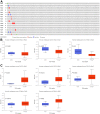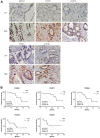Comprehensive bioinformatics analysis reveals the significance of forkhead box family members in pancreatic adenocarcinoma
- PMID: 36622275
- PMCID: PMC9876641
- DOI: 10.18632/aging.204455
Comprehensive bioinformatics analysis reveals the significance of forkhead box family members in pancreatic adenocarcinoma
Abstract
Background: Forkhead box proteins (FOXs) play important roles in multiple biological processes; while little is known regarding the role of FOX members in pancreatic adenocarcinoma (PAAD). This study aimed to comprehensively investigate the function of FOX family members in PAAD.
Methods: Expression and prognostic value of FOXs were analyzed by R language and GEPIA. Genetic alteration and promoter methylation level were analyzed using CBioPortal and UALCAN. Protein-protein interactions and gene functions were analyzed using STRING and DAVID. TIMER and SENESCopedia were utilized to analyze the correlation of FOXs with immune cell infiltration or tumor senescence. Protein levels of FOXs were detected by immunohistochemistry.
Results: Expression of 15 of 50 FOXs were significantly elevated in PAAD. Among these 15 differentially expressed FOXs (DE-FOXs), 4 were significantly associated with the clinical cancer stage and 4 were negatively associated with overall survival. Functions of DE-FOXs were related to epithelial tube morphogenesis, nuclear chromatin, and DNA-binding. Promoter methylation and genomic alterations were not major causes of FOX dysregulation. Most DE-FOX was correlated with diverse immune infiltration cells. Seven of the DE-FOXs were positively related to tumor senescence. The protein levels of FOXM1, FOXP1, and FOXN3 were negatively correlated with OS in the collected PAAD patients.
Conclusions: FOXM1, FOXP1, and FOXN3 have prognostic value. Seven FOXs were related senescence, whereas most DE-FOXs were related to immune infiltration in PAAD. Our findings are instructive for future research on FOX family and provide novel insights into the selection of FOXs with potential prognostic or therapeutic target value.
Keywords: biomarker; forkhead box family; pancreatic adenocarcinoma; prognosis; senescence.
Conflict of interest statement
Figures







Similar articles
-
Bioinformatics analysis identified MMP14 and COL12A1 as immune-related biomarkers associated with pancreatic adenocarcinoma prognosis.Math Biosci Eng. 2021 Jun 30;18(5):5921-5942. doi: 10.3934/mbe.2021296. Math Biosci Eng. 2021. PMID: 34517516
-
The role of transcription factor FOXA1/C2/M1/O3/P1/Q1 in breast cancer.Medicine (Baltimore). 2024 Apr 12;103(15):e37709. doi: 10.1097/MD.0000000000037709. Medicine (Baltimore). 2024. PMID: 38608123 Free PMC article.
-
Integrated analysis identified the role of three family members of ARHGAP in pancreatic adenocarcinoma.Sci Rep. 2024 May 23;14(1):11790. doi: 10.1038/s41598-024-62577-z. Sci Rep. 2024. PMID: 38783033 Free PMC article.
-
Role of forkhead box gene family in bone metabolism.J Cell Physiol. 2020 Mar;235(3):1986-1994. doi: 10.1002/jcp.29178. Epub 2019 Sep 24. J Cell Physiol. 2020. PMID: 31549399 Review.
-
Human FOX gene family (Review).Int J Oncol. 2004 Nov;25(5):1495-500. Int J Oncol. 2004. PMID: 15492844 Review.
Cited by
-
The FOXP1-ABCG2 axis promotes the proliferation of cancer stem cells and induces chemoresistance in pancreatic cancer.Cancer Gene Ther. 2025 May;32(5):563-572. doi: 10.1038/s41417-025-00896-7. Epub 2025 Apr 1. Cancer Gene Ther. 2025. PMID: 40169859 Free PMC article.
-
Investigating the role of FOX gene family in development and stress response in Labeo rohita: A multi-faceted analysis of phylogeny and genome characterization.PLoS One. 2025 Aug 21;20(8):e0323740. doi: 10.1371/journal.pone.0323740. eCollection 2025. PLoS One. 2025. PMID: 40839711 Free PMC article.
References
-
- Assenat E, de la Fouchardière C, Portales F, Ychou M, Debourdeau A, Desseigne F, Iltache S, Fiess C, Mollevi C, Mazard T. Sequential first-line treatment with nab-paclitaxel/gemcitabine and FOLFIRINOX in metastatic pancreatic adenocarcinoma: GABRINOX phase Ib-II controlled clinical trial. ESMO Open. 2021; 6:100318. 10.1016/j.esmoop.2021.100318 - DOI - PMC - PubMed
Publication types
MeSH terms
Substances
LinkOut - more resources
Full Text Sources
Medical
Miscellaneous

